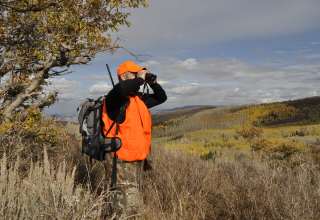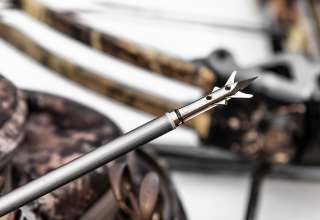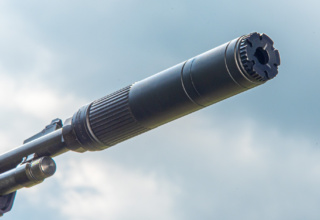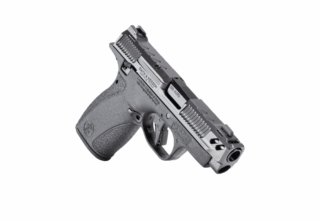Crossbow hunters are like rifle hunters with shooting stances. Most center-fire marksmen shoot from a bench rest and tend to seek that position wherever possible. Because most shooting situations improve with support, crossbow hunters follow the same practice. The two differ in target range. Marksmen may shoot at hundreds, out to 1,000 yards and such precision requires a solid rest. Crossbow hunters, on the other hand, shoot at relatively close range at targets 40 yards or less. Should a big buck walk toward your stand, pause broadside and stick its head in the leaves, rest your crossbow and squeeze the trigger.
Realistic Practice
 Typically, that perfect shot doesn’t happen because the animal is closer, farther, behind an obstruction or a zillion other nuances that make hunting a challenge. These situations are compounded if you are stuck on shooting sticks or other form of solid rest. You need to be versatile and flexible in your shooting form which means shooting off-hand. I literally wrote the book on crossbow hunting (The Ultimate Guide to Crossbow Hunting) in which I urge hunters to practice from the offhand position.
Typically, that perfect shot doesn’t happen because the animal is closer, farther, behind an obstruction or a zillion other nuances that make hunting a challenge. These situations are compounded if you are stuck on shooting sticks or other form of solid rest. You need to be versatile and flexible in your shooting form which means shooting off-hand. I literally wrote the book on crossbow hunting (The Ultimate Guide to Crossbow Hunting) in which I urge hunters to practice from the offhand position.
Shooting accurately is a combination of confidence and trigger pull. If you start practicing offhand, you will quickly realize how easy it can be. I practice regularly at 50 yards and have no problem pulling up on an elk at 40 yards to squeeze off a shot. I’d prefer to be sitting with the bow rested on my knee, yet I can make that shot every time and with a little practice you can too.
Balancing Act
 Crossbows with quiver attached weigh between seven and ten pounds, about the same as high-powered rifles. Crossbow triggers tend to be heavier than center-fire rifles which means the shooter must practice a steady pull, rather than the slow l squeeze of center-fire. Balance plays a part here as you want a bit more weight forward to help with trigger pull. For right handed shooters, as the weight of the bow quiver and riser push down on your left hand, it helps the squeeze of the right.
Crossbows with quiver attached weigh between seven and ten pounds, about the same as high-powered rifles. Crossbow triggers tend to be heavier than center-fire rifles which means the shooter must practice a steady pull, rather than the slow l squeeze of center-fire. Balance plays a part here as you want a bit more weight forward to help with trigger pull. For right handed shooters, as the weight of the bow quiver and riser push down on your left hand, it helps the squeeze of the right.
TenPoint, Horton, and Wicked Ridge bows are designed to be slightly weight-forward so that they swing vertically and provide enough mass for a steady aim and solid trigger pull.
Once you have this process perfected, you’ll sight on your target and in the next instant the bow will launch. Just as with a compound bow, or shotgun on sporting clays, the trigger pull becomes second nature and your total focus is on aiming.
Beating Buck Fever
Target shooters experience target panic in a comparable way. As they try to print a perfect group, the first two rounds may touch, yet that third bullet often flies awry. Shots “one” and “two” were made without pressure, yet the shooter feels the anxiety of being perfect and becomes his own worst enemy.
Buck fever is like that as well. The best way to guard against it is to develop that balance, aim, fire method so that the arrow launches almost instinctively. Once you develop confidence and build a consistent shot, you’ll have that “put me in coach” attitude that begs for a chance to shoot.
When you spot game, estimate its course, and select the best shooting spot for distance and angle. If you are in close, brushy areas, you may need to keep the buck in your scope until that tiny opening occurs. If the animal is approaching through a wide opening, you may want to bide your time and not raise the bow until you are ready to shoot.
Off-Hand or Rest
 If you hunt from a permanent tree stand or shooting house, be careful about resting the bow solidly against the structure. I watched an Ohio doe feed toward me, rested the bow solidly on the side of the stand, and squeezed. The vibration from the launch resonated through the timbers and nearly caused the deer to duck my arrow. Fortunately, TenPoint bows shoot with great speed and I soon found it. If you use a rest, always lay the bow on your hand to help dampen the vibration, or use the balance of the bow and make the shot off-hand.
If you hunt from a permanent tree stand or shooting house, be careful about resting the bow solidly against the structure. I watched an Ohio doe feed toward me, rested the bow solidly on the side of the stand, and squeezed. The vibration from the launch resonated through the timbers and nearly caused the deer to duck my arrow. Fortunately, TenPoint bows shoot with great speed and I soon found it. If you use a rest, always lay the bow on your hand to help dampen the vibration, or use the balance of the bow and make the shot off-hand.
- Long Range Hunting - January 9, 2019
- Travel Smarter with Crossbows - November 24, 2018
- Portable Ambush Blind – The NAP Mantis - September 7, 2018

















